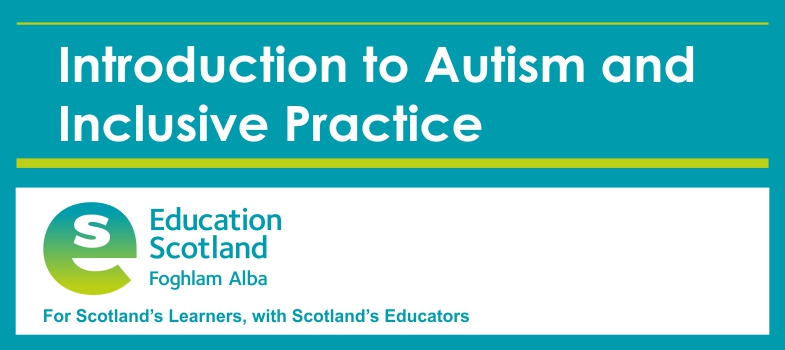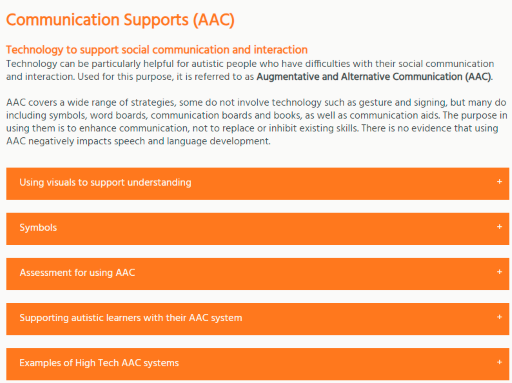3.4 Supporting communication
Key strategies
- reduce your language
- use the person’s name to cue them in
- focus on teaching the names of key people
- provide opportunities for initiation
- use visual supports
- allow time … wait
Individualised, stage-specific strategies and supports can be discussed with the team around the child.
Technology to support social communication and interaction
Technology can be particularly helpful for autistic people who have difficulties with their social communication and interaction. Used for this purpose, it is referred to as Augmentative and Alternative Communication (AAC).
AAC covers a wide range of strategies: some do not involve technology such as gesture and signing, but many do, including symbols, word boards, communication boards and books, as well as communication aids. The purpose in using them is to enhance communication, not to replace or inhibit existing skills. There is no evidence that using AAC negatively impacts speech and language development.
Many AAC strategies are visual and relatively static. Spoken language, on the other hand, is auditory and always transitory by nature. Some people process information better when they are looking at pictures or written words to help them visualise spoken information.
Visual supports for communication often take the form of picture symbol sets used through pointing by those in the environment to supplement their speech. As well as supporting understanding, this also provides a model to the individual on how they can use symbols to get a message across. This teaching technique is often referred to as Aided Language Stimulation.
Autistic learners can benefit from the use of symbols in their environment and within their AAC system, whether printed (low tech) or electronic (high tech).
There is a range of picture symbol sets and software for printing visuals, including:
- Boardmaker using Picture Communication Symbols (PCS)
- Matrix Maker Plus which uses Widgit symbols, SymbolStix and Inclusive Technology symbols.
Low-tech AAC systems
It is important to consider the use of low-tech AAC systems, which include:
- pen and paper to write messages or draw
- alphabet and word boards
- communication charts or books with pictures, photos and symbols.
Some low-tech systems have been designed primarily for use by autistic learners. These include:
Picture Exchange Communication System (PECS) – designed to teach autistic learners the basic concept of communication. At its core is the shaping and developing of communication activity, encouraging the individual to give a symbol to another person. That person giving the desired object in return
Pragmatic Organisation Dynamic Display (PODD) – an approach that involves giving individuals access to a large vocabulary of words in a symbol communication book, based on the way that we use language socially and taught through modelling. It is also available in some communication devices and apps.
The Toolbox has additional information and downloadable resources to support communication as highlighted in Figure 10.
Activity 7
- Go to the Communication Supports [Tip: hold Ctrl and click a link to open it in a new tab. (Hide tip)] page on the Toolbox for further information on:
- using visual supports to support understanding
- symbols
- assessment for using AAC
- supporting autistic learners with the AAC system
- examples of high-tech AAC systems.
- Watch the short introduction film.
Autistic people and their families told us that the big five things that they wanted the public to understand were that autistic people can:
- need extra time to process information
- experience anxiety in social situations
- experience anxiety with unexpected changes
- find noise, smells and bright lights painful and distressing
- become overwhelmed and experience a 'meltdown' or 'shutdown'.
All of these areas will have an impact on being able to effectively communicate.
Expressive language
At least 50% of autistic people have a co-occurring developmental language disorder which can affect their speech, language and communication.
- Language can be measured in the words we use (vocabulary) and the way we put these together (grammar) and length of utterance.
- Expressive language may include echolalia (repeating words and phrases from people, TV or computers) or spontaneous and creative speech.
- Verbal dyspraxia affects the fluent articulation of speech, due to difficulties with planning motor movements for speech.
- Language can be expressed through words, pictures or signs.
Social communication
Difficulty understanding and using social communication according to the conventions of the local context affects individuals across the lifespan. This is not something that can be ‘fixed’. Social communication skills do develop and can be scaffolded, however, as individuals transition to new roles and activities in life, additional support might be required at each stage.
Some difficulties may be more apparent, such as those who talk repetitively or endlessly about a favourite topic. Others may be more subtle, such as those who ‘copy’ social behaviours or very rarely initiate and wait for other to take the lead in social interactions.
Metacognition
At the conversation partner stage, children begin to develop the ability to reflect upon their knowledge, learning and actions. Prior to this stage social skills, groups are not recommended (see NAIT Guidance on Social Communication Groups).
Peers
Peer interaction is often harder than interaction with those older and younger. Adults are likely to make adaptations and younger children’s communication is likely to be less sophisticated and demanding.
Groups can be more difficult than 1:1 interaction and therefore collaborative learning can present challenges. Reasonable adjustments may include:
- allocation of clear roles
- scripts
- sticking to familiar rather than new activities in groups
- having a familiar and supportive peer
- having predictability
- a range of visual supports
- at the secondary stage, individuals with good language skills and motivation to make friends might benefit from taking part in focused work on this (e.g. the PEERS programme).
Masking and camouflaging
Some autistic people use masking and camouflage as coping strategies. These may be intentional or unconscious habits (‘Putting on My Best Normal’: Social Camouflaging in Adults with Autism Spectrum Conditions, Hull et al., 2017).
Activity 8
In your Reflective Log, consider and note down how social communication differences may impact on an autistic learner’s educational activities and interactions.
Here are some examples.
Differences in social communication might affect the ability to:
Answer
- respond to group instructions
- take turns appropriately in group discussion
- understand ‘implied’ meanings, affecting aspects of literacy
- process information and respond within expected time
- organise several instructions given together
- remember or follow information or instructions given verbally.
Some autistic learners may have delayed language, but the degree of impairment varies greatly. Some may remain non-verbal throughout their life; others may have limited skills, only using speech to communicate their needs.
Supporting communication – key strategies
- reduce your language
- use the person’s name, to cue them in
- focus on teaching the names of key people
- provide opportunities for initiation
- use visual supports
- allow time … wait
- individualised, stage-specific strategies and supports can be discussed with the team around the child.
3.3 Communication and autism

